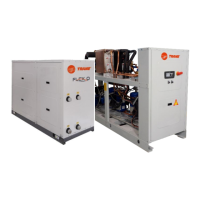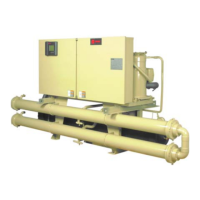Page 5
The legal representative of the company appointed by the owner to position and hydraulically, electrically etc. connect the
Trane unit to the plant: he or she is responsible for moving and the correct installation of the unit in accordance with the
indications in this manual and with the national regulations in force.
Operator:
A person authorized by the owner to carry out all the operations of regulation and control on the Trane unit which are
specifically mentioned in this manual. He or she should keep to actions described in the manual and limit his or her action
to what is explicitly allowed.
Technician:
A person who is directly authorized by Trane or, secondarily, for all EU countries except for Italy, by the distributor of the
Trane product, under their own responsibility, to carry out all ordinary or extraordinary maintenance operations, as well as
regulations, controls, repairs and parts replacement which may be necessary during the lifetime of the unit.
2.2
ACCESS TO DANGEROUS AREA
Access to the unit dangerous areas is usually obstructed through protection panels, which are removable, by using a tool.
For all the units which allow access to the cooling piping without security gratings (optional) or closing panels, the
following precautions must be taken:
- mark the areas with contact risks
- apply warning signs
The danger zone must be of a suitable size to avoid any contact, even accidental contact.
Trane declines any responsibility for damage to things and unauthorized personnel in case of absence of clear and static
limiting systems of the risk area(s) and of the relevant warning and danger signs.
2.3
GENERAL PRECAUTIONS
The operator must only intervene on the unit commands; he or she must not open any panels except for the one which
gives access to the command module.
The installer must only intervene on the connections between the plant and the unit; he or she must not open any unit
panels nor carry out any commands.
The following precautions should be made when approaching or working on the unit:
• Do not wear jewelry, baggy clothes or any other accessory which can get caught up.
• Use appropriate protection (gloves, glasses etc.) when using an open flame (welding) or compressed air.
• If the unit is located in a closed environment, wear hearing protection.
• Before disconnecting, removing tubes, filters, joints or other line parts intercept the connection tubes, empty them
until the pressure reaches that of the atmosphere.
• Do not use your hands to check for possible pressure losses.
• Always use tools which are in good condition; make sure the instructions have been fully understood before using the tools
• Make sure that any tools, electrical cables or other loose objects have been removed before closing the unit and
starting it up again.
2.4
PRECAUTIONS AGAINST RISKS DUE TO THE REFRIGERANT
Splashes or sprinkles can cause chill burns. The risk of absorptions through the skin is not relevant.
R410a refrigerant could take some lightly irritating effects and in liquid stage it has a strong skinning effect. In this case it is
necessary to rinse with fresh water the contaminated parts of the skin
refrigerant in liquid stage in contact with wet fabrics cause freezing and adherence to the skin. In this case it is necessary to
put off the contaminated clothes to avoid freezing. Please contact a doctor in case of irritation of the contaminated parts.
Risks for contact with the
eyes
Vapors don’t take any effect. Splashes or sprinklers can cause chill burns. In those cases it is necessary to
the eyes with water or with solution for ocular washings for 10 minutes. The intervention of a doctor is needed.
Should it happen, it causes chill burns. It does not cause vomiting. The person must be kept awake. It is needed to rinse the
esh water and to drink almost 0.25 liters. The intervention of a doctor is needed.
High concentration of vapors in air can lead to an
esthetic effects up to a loss of conscience. Long exposures could give
rise to cardiac arrhythmia and sometimes even to death.
High concentrations can create a reduction of oxygen in air, with consequent possibility of suffocation. Should it happen the
person must be taken to the open air and let him take a rest.
Administer oxygen if needed. In case the breathing has
interrupted or become irregular, it is necessary to
apply the artificial breathing. In case of cardiac arrest a heart massage must be applied. Contact a doctor immediately.

